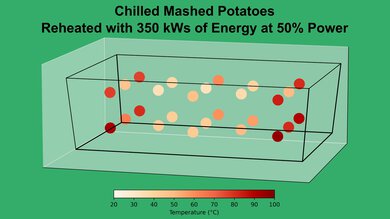The Panasonic NN-SC67NS is one of the brand's lower-end inverter microwaves. This cheaper option from Panasonic is a little bigger than the Panasonic NN-SN67HS but otherwise has similar features. It includes sensor cooking and reheating programs that detect steam to adjust the cooking time, various functions like 'Keep Warm,' and a mute controls option.
Our Verdict
The 1200-watt Panasonic NN-SC67NS has a high heating rate; it'll heat food just as fast as the Panasonic NN-SN975S, despite that model's advertised 1250-watt output power.
- Heats food quickly.
- Sensor cooking functions.
- Mute controls option.
- Too small for some uses.
Check Price
Differences Between Sizes And Variants
This microwave comes in one stainless steel variant. You can see the label for the unit we tested here.
If you encounter another variant, let us know in the comments, and we'll update our review.
Popular Microwave Comparisons
The Panasonic NN-SC67NS is a smaller, cheaper inverter microwave compared with other models from the brand, like the Panasonic NN-SN67HS and the Panasonic NN-SN975S. It has a sensor cooking feature, unlike some similarly-priced microwaves like the GE JES1109RRSS, which is good news if you want a more automatic microwaving experience. While it's on the smaller side, you might prefer something even more compact, like the Cuisinart CMW-70, if your kitchen is especially short on counter space.
If you're looking for a recommendation, check out the best microwaves and the best over-the-range microwaves.
Test Results

Aside from the usual ten manual power settings, it has a 'Sensor reheat' function and 15 'Sensor cook' functions. The microwave detects steam and automatically adjusts the cooking time. Like with most microwaves, you must refer to the manual to know which 'Sensor cook' function you've selected since the microwave only displays the corresponding number for each program. There's also a popcorn setting, a beverage setting, and the rarer 'Keep warm' function. You can also create a custom cooking program with 2-3 stages or set a 'Standing time' that sets a timer after the microwave is done. If you have a lot going on in the kitchen, you can even set a delayed start so you don't forget later on.
This microwave has an inverter, meaning it's meant to maintain a constant power output at all power levels instead of always operating at 100% power and cycling on and off on lower settings. However, while it has a consistent power draw with the 100%, 70%, and 50% settings, it seems to power on and off at 20% power. That said, that won't affect heating evenness.
Microwaves all perform similarly when heating food in shallow dishes. The evenness of heating depends on where you place your dish and your specific food. You can read more about our investigation into microwave performance here.
Like with shallow dishes, microwaves all heat food in deep containers similarly evenly. The evenness depends on what kind of food you're reheating, your container, and where you place it. If you're curious about how we investigated microwave performance, check out more information here.







